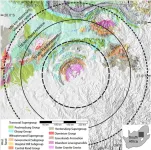(Press-News.org) Peer-reviewed / Randomised trial / People
Planned interim safety analysis of the first randomised trial investigating the use of AI in a national breast cancer screening programme underscores the potential of AI to make mammography screening more accurate and efficient.
Interim findings from a cohort of over 80,000 women in Sweden reveal AI-supported screening detected 20% more cancers compared with the routine double reading of mammograms by two breast radiologists.
The use of AI did not increase false positives (when a mammogram is incorrectly diagnosed as abnormal) and reduced the mammogram reading workload by 44%.
However, primary outcome results are not expected for several years and will establish whether AI reduces interval cancers (cancers diagnosed between screenings) in 100,000 women with at least two years follow-up, and ultimately whether AI’s use in mammography screening is justified.
An interim safety analysis of the first randomised controlled trial of its kind involving over 80,000 Swedish women published in The Lancet Oncology journal, finds artificial intelligence (AI)-supported mammography analysis is as good as two breast radiologists working together to detect breast cancer, without increasing false positives and almost halving the screen-reading workload.
However, the final trial results looking at whether the use of AI in interpreting mammography images translates into a reduction in interval cancers (cancers detected between screenings that generally have a poorer prognosis than screen-detected cancers) in 100,000 women followed over two years—and ultimately whether AI’s use in mammography screening is justified—are not expected for several years.
“These promising interim safety results should be used to inform new trials and programme-based evaluations to address the pronounced radiologist shortage in many countries. But they are not enough on their own to confirm that AI is ready to be implemented in mammography screening,” cautions lead author Dr Kristina Lång from Lund University, Sweden. “We still need to understand the implications on patients’ outcomes, especially whether combining radiologists’ expertise with AI can help detect interval cancers that are often missed by traditional screening, as well as the cost-effectiveness of the technology.” [1]
Breast cancer screening with mammography has been shown to improve prognosis and reduce mortality by detecting breast cancer at an earlier, more treatable stage. However, estimates suggest that 20-30% of interval cancers that should have been spotted at the preceding screening mammogram are missed, and suspicious findings often turn out to be benign.
European guidelines recommend double reading of screening mammograms by two radiologists to ensure high sensitivity (to correctly identify those with disease). But there is a shortage of breast radiologists in many countries, including a shortfall of around 41 (8%) in the UK in 2020 [2] and about 50 in Sweden, and it takes over a decade to train a radiologist capable of interpreting mammograms.
AI has been proposed as an automated second reader for mammograms that might help reduce this workload and improve screening accuracy. The technology has shown encouraging results in retrospective studies using AI to triage examinations to either single or double reading and by providing radiologists with computer-aided detection (CAD) marks highlighting suspicious features to reduce false negative results. But robust evidence from prospective randomised trials has been lacking.
Between April 2021 and July 2022, 80,033 women aged 40-80 years who had undergone mammogram screening at four sites in southwest Sweden were randomly assigned in a 1:1 ratio to either AI-supported analysis, where a commercially available AI-supported mammogram reading system [3] analysed the mammograms before they were also read by one or two radiologists (intervention arm), or standard analysis performed by two radiologists without AI (control arm).
This interim analysis of the Mammography Screening with Artificial Intelligence (MASAI) trial compared early screening performance (e.g., cancer detection, recalls, false positives) and screen-reading workload in the two arms. The MASAI trial will continue to establish primary outcome results of whether AI-supported mammography screening reduces interval cancers.
The lowest acceptable limit for clinical safety in the intervention group was set at a cancer detection rate above three cancers per 1,000 screened women. This was based on the premise that the cancer detection rate might decline because the majority of screening examinations would undergo single reading instead of double reading. The baseline detection rate in the current screening programme with double reading is five cancers per 1,000 screened women.
In the AI-supported analysis, the AI system first analysed the mammography image and predicted the risk of cancer on a scale of one to 10, with one representing the lowest risk and 10 the highest. If the risk score was less than 10 the image was further analysed by one radiologist, whereas if the AI system predicted a risk score of 10 then two radiologists analysed the image.
The system also provided CAD marks to assist radiologists in accurately interpreting mammography images. Women were recalled for additional testing based on suspicious findings. Radiologists had the final decision to recall women and were instructed to recall cases with the highest 1% risk, except for obvious false positives.
AI failed to provide a risk score in 0·8% of cases (306/39,996) that were referred to standard care (double reading).
The recall rates averaged 2.2% (861 women) for AI-supported screening and 2.0% (817 women) for standard double reading without AI. These were similar to the average 2.1% recall rate in the clinic six months prior to the trial starting, indicating that cancer detection rates had not fallen.
In total, 244 women (28%) recalled from AI-supported screening were found to have cancer compared with 203 women (25%) recalled from standard screening—resulting in 41 more cancers detected with the support of AI (of which 19 were invasive and 22 were in situ cancers). The false-positive rate was 1·5% in both arms.
Overall, AI-supported screening resulted in a cancer detection rate of six per 1,000 screened women compared to five per 1,000 for standard double reading without AI—equivalent to detecting one additional cancer for every 1,000 women screened.
Importantly, there were 36,886 fewer screen readings by radiologists in the AI-supported group than in the control group (46,345 vs 83,231), resulting in a 44% reduction in the screen-reading workload of radiologists.
Although the actual time saved by using AI was not measured in the trial, the researchers calculate that if a radiologist reads on average 50 mammograms an hour, it would have taken one radiologist 4·6 months less to read the roughly 40,000 screening examinations with the help of AI compared with the roughly 40,000 in the control arm that were double read.
“The greatest potential of AI right now is that it could allow radiologists to be less burdened by the excessive amount of reading,” says Lång. “While our AI-supported screening system requires at least one radiologist in charge of detection, it could potentially do away with the need for double reading of the majority of mammograms easing the pressure on workloads and enabling radiologists to focus on more advanced diagnostics while shortening waiting times for patients.” [1]
Despite the promising findings, the authors note several limitations including that the analysis was conducted at a single centre and was limited to one type of mammography device and one AI system which might limit the generalisability of the results. They also note that while technical factors will affect the performance and processing of the AI system, these will likely be less important than the experience of radiologists. Because the AI-supported system places the final decision on whether to recall women on radiologists, the results are dependent on their performance. In this trial, radiologists were moderately to highly experienced, which could limit the generalisability of the findings to less experienced readers. Lastly, information on race and ethnicity was not collected.
Writing in a linked Comment, Dr Nereo Segnan, former Head of the Unit of Cancer Epidemiology and past Director of Department of Screening at CPO Piemonte in Italy (who was not involved in the study) notes that the AI risk score for breast cancer seems very accurate at being able to separate high risk from low-risk women, adding that, “In risk stratified screening protocols, the potential for appropriately modulating the criteria for recall in low-risk and high-risk groups is remarkable.”
However, he cautions that: “In the AI-supported screening group of the MASAI trial, the possible presence of overdiagnosis (ie, the system identifying non-cancers) or over-detection of indolent lesions, such as a relevant portion of ductal carcinomas in situ, should prompt caution in the interpretation of results that otherwise seem straightforward in favouring the use of AI...It is, therefore, important to acquire biological information on the detected lesions. The final results of the MASAI trial are expected to do so, as the characteristics of identified cancers and the rate of interval cancers—not just the detection rate—are indicated as main outcomes. An important research question thus remains: is AI, when appropriately trained, able to capture relevant biological features—or, in other words, the natural history of the disease—such as the capacity of tumours to grow and disseminate?”
NOTES TO EDITORS
This study was funded by the Swedish Cancer Society, Confederation of Regional Cancer Centres, and Governmental funding for clinical research. It was conducted by researchers from Lund University, Malmö, Sweden, Unilabs Mammography Unit at Skåne University Hospital, Malmö, Sweden; Cancer Registry of Norway, Oslo, Norway; The Arctic University of Norway, Tromsø, Norway.
[1] Quotes direct from authors and cannot be found in text of paper.
[2] Clinical radiology UK workforce census 2020 report (rcr.ac.uk)
[3] The AI Transpara system (version 1.7.0) uses deep learning to identify and interpret mammographic regions suspicious for cancer. It is developed with over 200,000 examinations for training and testing, which were obtained from multiple institutions in more than 10 countries. Annotations of over 10,000 cancers in the database are based on biopsy results and include regions marked in prior mammograms where cancers were visible but not detected by radiologists. Additional information is available at https://screenpoint-medical.com
The labels have been added to this press release as part of a project run by the Academy of Medical Sciences seeking to improve the communication of evidence. For more information, please see: http://www.sciencemediacentre.org/wp-content/uploads/2018/01/AMS-press-release-labelling-system-GUIDANCE.pdf if you have any questions or feedback, please contact The Lancet press office pressoffice@lancet.com
IF YOU WISH TO PROVIDE A LINK FOR YOUR READERS, PLEASE USE THE FOLLOWING, WHICH WILL GO LIVE AT THE TIME THE EMBARGO LIFTS: https://www.thelancet.com/journals/lanonc/article/PIIS1470-2045(23)00298-X/fulltext
END
THE LANCET ONCOLOGY: First randomised trial finds AI-supported mammography screening is safe and almost halved radiologist workload
2023-08-02
ELSE PRESS RELEASES FROM THIS DATE:
Royal Ontario Museum researchers identify oldest known species of swimming jellyfish
2023-08-02
Royal Ontario Museum (ROM) announces the oldest swimming jellyfish in the fossil record with the newly named Burgessomedusa phasmiformis. These findings are announced in the journal Proceedings of the Royal Society B.
Jellyfish belong to medusozoans, or animals producing medusae, and include today’s box jellies, hydroids, stalked jellyfish and true jellyfish. Medusozoans are part of one of the oldest groups of animals to have existed, called Cnidaria, a group which also includes ...
Earth’s most ancient impact craters are disappearing
2023-08-01
This press release is available online at: https://news.agu.org/press-release/earths-most-ancient-impact-craters-are-disappearing/
AGU press contact:
Rebecca Dzombak, news@agu.org (UTC-4 hours)
Contact information for the researchers:
Matthew S. Huber, University of the Western Cape, mhuber@uwc.ac.za (UTC+2 hours)
WASHINGTON — Earth’s oldest craters could give scientists critical information about the structure of the early Earth and the composition of bodies in the solar system as well as help to interpret crater records on other ...
Sea level rise shifts habitat for endangered Florida Keys species
2023-08-01
The silver rice rat, an endangered species endemic to the Florida Keys, makes its home as close to the shoreline as possible for easy access to its low-tide marine species diet.
It is this proximity to the water that prompted a team of scientists at the University of Florida to examine the rats’ movement in correlation with historical tidal data over 17 years. The sea level rose 0.142 meters between 2004 and 2021, and the researchers also found that the rats moved to higher ground. In fact, the rats ...
Pecans give obesity and diabetes a slim chance
2023-08-01
By Adam Russell
A new research study shows pecans may help prevent obesity and reduce inflammation. (Texas A&M AgriLife photo by Laura McKenzie)
“Obesity and diabetes numbers are increasing in modern society worldwide, and the trend in high fat diet consumption is one of the main reasons besides lifestyle and genetic predisposition,” said Luis Cisneros-Zevallos, Ph.D., professor of horticulture and food science in the Department of Horticultural Sciences in the Texas A&M College of Agriculture and ...
Lead exposure in early life linked to higher risk of criminal behavior in adulthood
2023-08-01
WASHINGTON (August 1, 2023)— New analysis from researchers at the George Washington University links lead exposure either in utero or during childhood with an increased risk of engaging in criminal behavior in adulthood. While prior research has found an association between lead exposure and criminal behavior at the aggregated population level, this is the first review to bring together the existing data at the individual-level of exposure and effects.
The first systematic review of available studies that address links between individual lead exposure and crime, or other antisocial behaviors, the research team’s analysis included 17 ...
VUMC participates in national study to test eye drops for nearsightedness
2023-08-01
A study conducted at Vanderbilt University Medical Center and 11 other hospitals and practices across the United States shows that use of low-dose atropine eyedrops, commonly used in a higher dose to treat lazy eye, was no better than a placebo at slowing myopia (nearsightedness) progression and elongation of the eye among children treated for two years.
The first randomized controlled trial of its kind aimed at identifying an effective way to manage myopia was published last week in JAMA Ophthalmology. It was conducted by the Pediatric Eye Disease Investigator Group and funded by the National Eye Institute (NEI).
“We found, interestingly, and honestly ...
Machine learning, blockchain technology could help counter spread of fake news
2023-08-01
BINGHAMTON, N.Y. -- A proposed machine learning framework and expanded use of blockchain technology could help counter the spread of fake news by allowing content creators to focus on areas where the misinformation is likely to do the most public harm, according to new research from Binghamton University, State University of New York.
The research led by Thi Tran, assistant professor of management information systems at Binghamton University’s School of Management, expands on existing studies by offering tools for recognizing patterns in misinformation and helping ...
Massachusetts General Hospital launches first-of-its-kind center for clinical transplant tolerance
2023-08-01
BOSTON – Massachusetts General Hospital (MGH), a founding member of the Mass General Brigham health system, officially opened the Legorreta Center for Clinical Transplant Tolerance, the first-of-its kind center in the world dedicated to preventing organ rejection after transplant surgery without the use of lifelong immunosuppressive medications. Immunosuppressive medications prevent the immune system from rejecting a transplanted organ, but come with serious side effects, increasing the chance of infections and other illnesses like cancer, diabetes, and heart disease. The mission of the Legorreta Center is to eliminate these risks by eliminating ...
Social media usage negatively impacts the schoolwork of students from adolescence to college research suggests
2023-08-01
Abstract
Research investigating social media use typically focus on late adolescents and young adults, despite a growing number of early adolescents, 93% to 97%—having at least one social media platform. Also, early adolescents are more likely to engage with newer sites, such as Snapchat and Instagram, than older platforms such as Facebook and Twitter. Given the evolving landscape of social media, the present study examines the impact of the use of various social media platforms, along with its moderating effects, on adolescents’ academic achievement, using a sample of N = 1,459 early adolescents. Results were such that, as frequency ...
Fructose intake driver of obesity, just like in hibernating animals, CU Researchers say
2023-08-01
AURORA, Colo. (July 31, 2023) – Researchers at the University of Colorado Anschutz Medical Campus have officially identified a central conduit to obesity: fructose.
While fructose’s contribution to obesity is well-known, a study published today in Philosophical Transactions aggregates a large amount of work to make a full argument for how fructose drives obesity and diseases such as diabetes and fatty liver disease.
“This is an in-depth review on a hypothesis that puts nature at the center of weight ...




